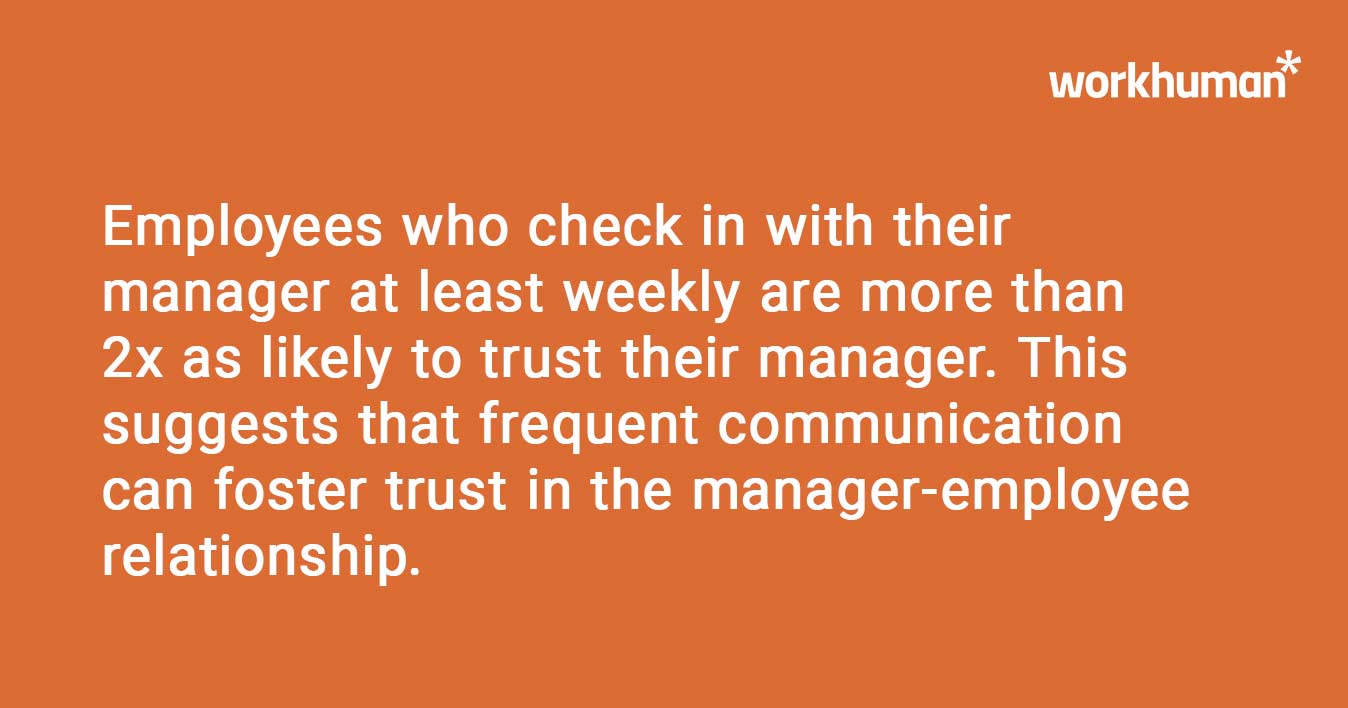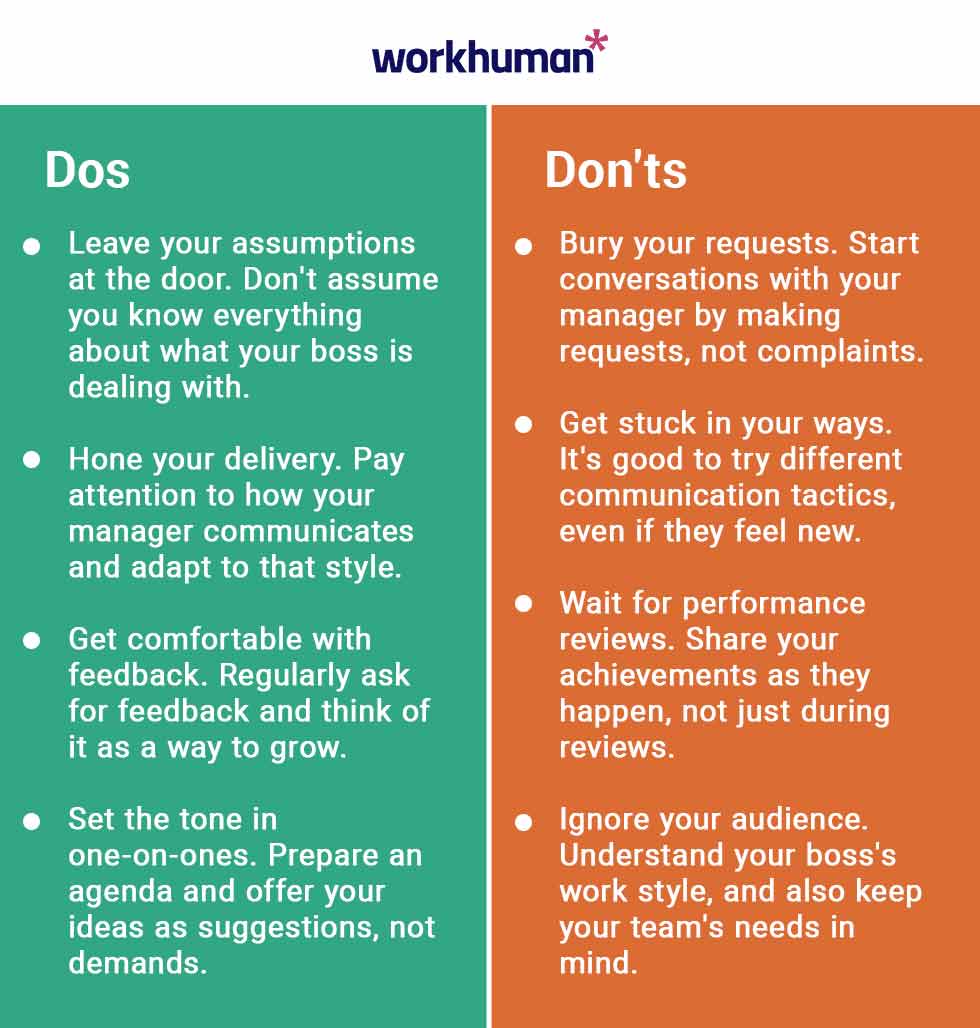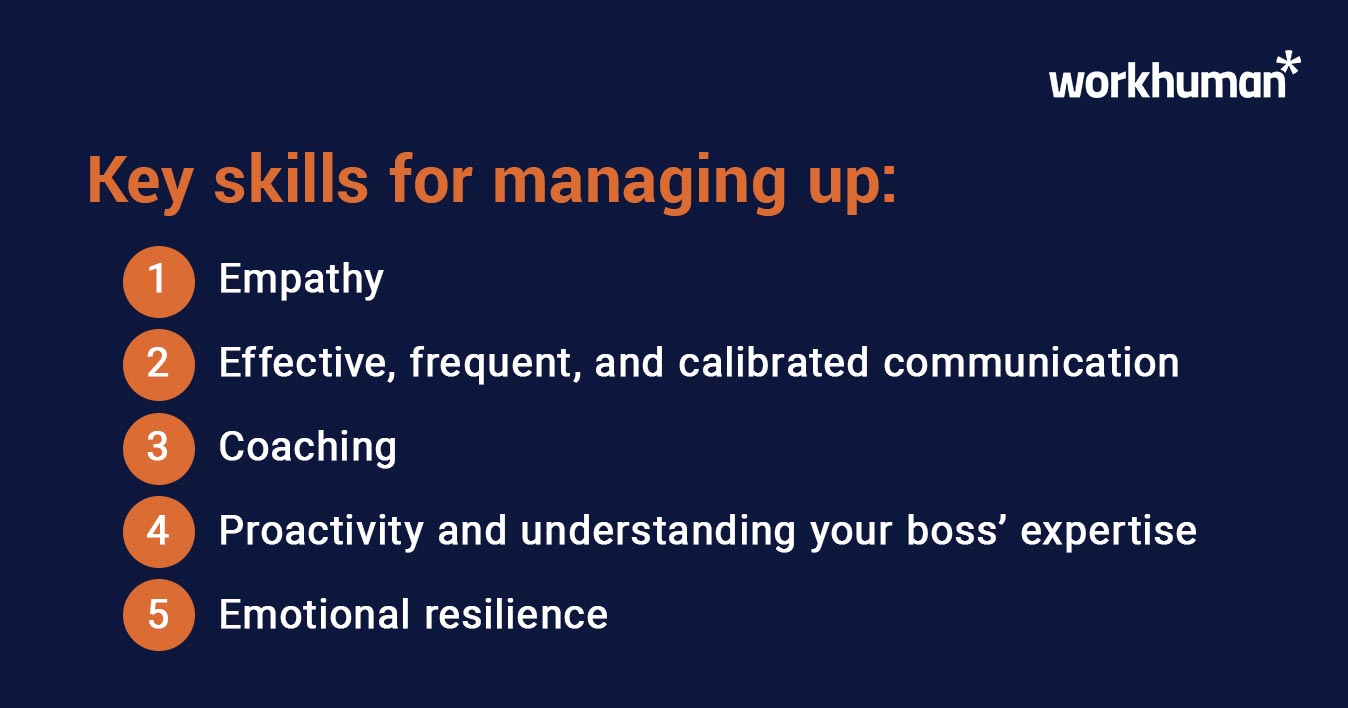Managing Up: Strategies to Enhance Your Relationship with Your Boss and Boost Your Career

A survey by Ladders found that 88%Opens in a new tab of high-earning professionals sees managing up as crucial for career advancement.
The skill of managing up can help you climb the corporate ladder, deal with difficult managers, and receive the credit you deserve for your hard work.
Keep reading to learn about the rewards, potential risks, practical examples, and everything else you need to know to manage up effectively.
What is managing up?
Managing up is a strategy for employees that helps to develop a productive working relationship with a manager or higher-level colleague. It involves recognizing the pressures they face, and understanding their communication style and objectives.
Learn how the WorkhumanⓇ Platform can transform employee engagement in your organization.
Why is managing up important?
At its core, managing up is about initiating a concise, clear, two-way communication style. This can help you define and meet the boss’ expectations and lead to a more productive working relationship. Managing up isn’t about going over a manager’s head.

Managing up is not just beneficial for navigating your current role; it’s pivotal for your long-term career trajectory. It can make your daily tasks go smoothly and lead to growth opportunities.
It is important to remember that managing up isn't about bypassing your manager. Managing up can be an effective career development card to play in bureaucratic work models.
Potential setbacks when managing up
When you start managing up, you should have an improved relationship with your boss. There’s always a risk that managers might not be receptive to your efforts. They might even think you’re trying to outflank them.
It's important to be aware of such potential drawbacks as well:
- Risk of miscommunication: It's key to keep communication clear to avoid misunderstanding or sending unintended messages.
- Overstepping boundaries: There’s a fine line between being proactive and overstepping. You want to make sure you do not make decisions that cross into areas beyond your role.
- Dependency: Unless done well, managing up can lead to a dependency where your boss might start expecting you to always take the lead on aligning with their style or decisions. This can hinder your autonomy.
- Neglecting peer relationships: If you prioritize managing up, you might put peer relationships on the back burner. Team dynamics are crucial, and it’s important to balance your upward management with lateral teamwork.
One way to avoid that is to be open about your intentions to make their job easier, handle your own work with less oversight, and strengthen your working relationship.
Best practices for managing up
Clarity of expectations is vital for creating a feedback culture, but not all managers get it right. In fact, Gallup estimates that only half of all employees really know what’s expected of them.
The key is to make sure you’re not among the unlucky half. To do that, you have to know what the manager is trying to achieve, what stresses them out, and your own professional goals. Then, you can find the shared points and align your day-to-day tasks to the big picture.
Understanding your boss's needs goes beyond just knowing the tasks you need to complete. It's crucial to grasp their vision of success for each specific assignment.
Don’t hesitate to ask how your performance will be evaluated. If your manager’s explanations are unclear, use something like the OKR framework (objective and key results) to add more definition to their idea of success.
Regular check-ins should help build trust, but there’s more to do to improve your employee-manager relationship. Master check-ins with this effective check-in checklist.
Open communication and discovering common interests can significantly strengthen your connection with your boss. If your company uses tools like Community Celebrations®, be sure to keep up with your manager’s updates. This not only shows your engagement but also helps in building a stronger rapport.
Here are some tips to help you cultivate a positive relationship with your supervisor:

Key strategies for managing up
Effectively managing up requires a combination of understanding, communication, and initiative. Below, we have summarized the key strategies to help you align better with your manager and enhance your working relationship:
- Understand their priorities: Start by learning what is most important to your manager. This aligns your work life balance and their goals and expectations from you and lets you work better.
- Communicate proactively: Maintain regular and open lines of communication. Don’t wait for them to ask for an update. Instead, keep them informed about your progress and challenges.
- Show initiative: Take the lead in proposing solutions, not just problems. This demonstrates your commitment to your role and the team's success.
- Seek feedback actively: Regular feedback is vital. According to Forbes' '10 Reasons why employees stay in a company', employees who receive frequent feedback feel more engaged and are less likely to quit.
- Adapt to their working style: Adjust your working and communication style to better suit your manager. This shows flexibility and a willingness to collaborate effectively.
- Schedule regular check-ins: As noted in a document from Workhuman, frequent check-ins can boost your alignment with your manager and help you meet your goals more effectively.
Short-term strategies
For immediate impact, consider these actionable steps that you can start implementing right away:
- Schedule regular check-ins: Set up a consistent schedule for one-on-one meetings with your manager to ensure ongoing communication and alignment.
- Prepare for meetings: Spend a few minutes before each check-in reviewing what was discussed previously to keep the conversation focused and productive.
- Start with positive recognition: Begin your interactions by highlighting what has gone well since your last meeting, setting a constructive tone for the discussion.
Long-term strategies
Efficiently dealing with managing your boss involves strategies that foster continuous improvement:
- Seek feedback regularly: Make it a habit to frequently ask for feedback. This not only helps you adjust to your manager's expectations but also demonstrates your commitment to personal growth.
- Align personal goals with managerial expectations: Continuously ensure that your personal career objectives align with your manager’s expectations and the overall goals of your organization.
- Invest in relationship building: Over time, work on developing a productive working relationship with your manager by understanding their challenges and anticipating their needs, enhancing trust and mutual respect.
Key skills for managing up
There are certain skills related to managing up that will help you build a healthy relationship with your boss. Let's talk through them.

Empathy
Relating to a bad manager isn’t always easy. When managing up, you need to replace your immediate response of anger with empathy.
With a bit of empathy in mind, you can reflect on why your manager is acting the way they are and what stressors might be at play.
Effective, frequent, and calibrated communication
Communication is a two-way street. To effectively manage up, you should initiate conversations instead of waiting for review meetings. Consider setting up daily or weekly direct reports.
But that’s not all. You also have to calibrate your communication to match your manager’s involvement to ensure a shared understanding of goal setting.
So, if your boss’s style leans towards disorganized laissez-faire, you can get away with drop-ins. On the other hand, if your manager is more reactive and likes to maintain tight control, it’s better to stick to scheduled meetings and detailed emails. This approach will help establish a consistent rhythm for both you and your manager.
Coaching
Coaching at work involves leading with thoughtful questions instead of direct statements. It's about tuning in to what's most important to your boss or direct report and collaboratively building a shared plan.
For instance, you can propose better systems for organizing files if being orderly isn’t your boss’ strong suit. Check out some positive leadership feedback examples if you’re unsure how to phrase your idea respectfully.
Proactivity and understanding your boss’ expertise
Managing up isn’t about pointing out your manager’s flaws. It’s about proactively improving workflows and communication to foster growth for both of you.
Begin by anticipating their needs and addressing them before they have to ask. This might include monitoring office supplies and keeping track of items that need repair or replacement to prevent any delays.
Alternatively, if you think, 'I want to make my boss’s life easier', you could volunteer to turn spreadsheets into intuitive charts and get them to make a quick decision.
Emotional resilience
Understanding when and how to respond or push back is crucial to managing people. A good rule of thumb is to let the small things slide.
If your manager cancels a meeting, reschedule immediately without making a fuss. If cancellations become frequent, explore other communication methods to make up for the missed meetings.
Examples of managing up in the workplace
1. Figuring out what makes micromanagers tick
A case study from Harvard Business ReviewOpens in a new tab provides an insightful example of managing up. In this study, an employee dealing with a micromanager discovered that their manager was primarily concerned about wasting time.
She proactively managed delays by informing her boss via email about the reasons and updated timelines. Additionally, she made it a point to arrive a few minutes early to meetings and consistently sent out an agenda with the estimated duration in advance.
Had the employee updated her micromanager on every single detail of her work, she'd end up overwhelmed with extra tasks. Instead, she focused on understanding and addressing her supervisor’s main concerns.
2. Extracting more info from vague bosses
If you're working with an indecisive supervisor, consider using Peter Drucker’s Management by Objectives (MBO) approach. Write a manager’s letter outlining the goals, tasks, priorities, and standards as you understand them.
Next, share your summary with your boss and seek their approval. If they have reservations about certain aspects, the letter will at least initiate a conversation. This approach encourages your supervisor to commit to specific objectives and agree on an actionable plan.
3. Handling multiple bosses with simple organizational tools
HBR’s “Monday morning to-do list” case study shows that managing up doesn’t only work for people who report directly to one boss.
In this scenario, an employee reports to two company partners and often feels overwhelmed managing urgent tasks from both. To handle this, she compiles a weekly to-do list detailing all her tasks and their deadlines, which she then shares with the partners. This helps manage expectations and streamline her workload.
In today's fast-evolving work landscape, fostering a robust company culture is more crucial than ever. A recent study by Gallup, in collaboration with Workhuman®, found that just one in four employees feel a real connection to their company's culture.
FAQs
What does it mean to manage up and across?
Managing up and across refers to not only managing up to your own manager but across teams and departments as well. The most effective employees have the ability to build trust and support with other team members to influence and benefit from their performance.
How do you talk about managing up?
When you’re talking about managing up, it’s important to note that it’s not a self-serving, manipulative tactic. Always remember that the ultimate goal is to achieve organizational goals, and you’re just looking for ways to make that possible with the current management.
Conclusion
Managing up is an art that demands patience and emotional intelligence. It requires keen observation, customized communication, resilience, and a generous helping of empathy to truly succeed.
As you navigate managing up, it’s crucial to strike the right balance. Invest a reasonable effort to align with your manager and enhance your working relationship, but always be mindful of not crossing into the territory of an exploitative workplace.
Remember, the goal is to create a mutually beneficial dynamic that fosters both personal growth and organizational success.
About the author
Ryan Stoltz
Ryan is a search marketing manager and content strategist at Workhuman where he writes on the next evolution of the workplace. Outside of the workplace, he's a diehard 49ers fan, comedy junkie, and has trouble avoiding sweets on a nightly basis.